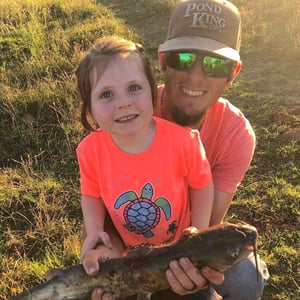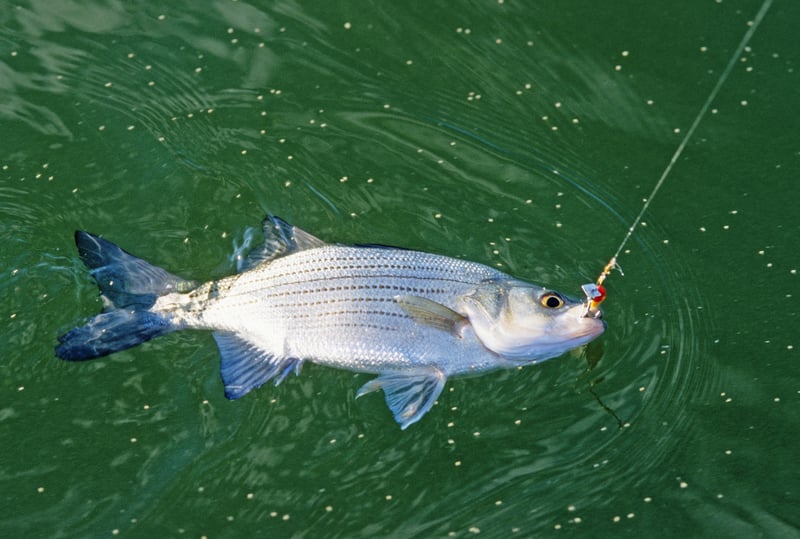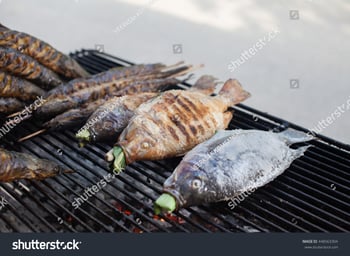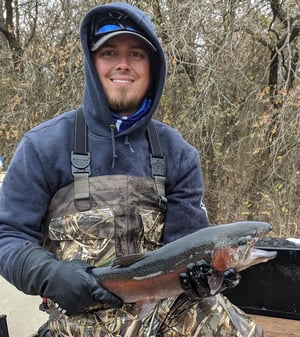Odds are, if you are a private landowner, you likely have a pond or lake somewhere on your property. Ponds are used for a variety of reasons, like farming and irrigation, but most times, land owners have ponds for recreation like swimming or our specialty, fishing!
We can professionally attest that not all ponds and lakes are created equal, and just like the diverse nature of their usage, so can the types of fishing that can take place in properly managed private waters.
So, if you’ve found yourself thinking about pond stocking, ask yourself these questions:
- Are you looking to spice things up down at the pond?
- Maybe add a little variety to your fishing experience?
- Or extend the fishing season so it lasts throughout the year?
If so, we have a few pond and lake management tips to help you diversify your fishing experience.
Want a Diverse Fishing Experience for Your Private Pond?
At Pond King, we spend a lot of time helping folks who are focused on largemouth bass production achieve their goals, but we also have customers who want a diversified fishing experience.
For a Diverse Fishing Experience, Bigger is Better
When trying to diversify your fishery, one thing to consider is to keep in mind how big your pond is and how many fish you are trying to put into it.
When it comes to creating a diversified fishing experience, size definitely matters. The bigger the body of water, the better, so you don't overpopulate your pond with fish and cause them to start competing with each other for resources.
The optimal size for multi-species ponds is 5 acres or bigger, because this allows the fish to spread out throughout a greater area without competing for resources as much as they would in a 1-acre pond.
Now, with the right management tactics, you might be able to have multiple species in a pond, but the more space for the fish, the better.
3 Reasons for Diversifying Your Private Lake
For the most part, we find that the reasons you might want a diverse fishing experience fall into these categories, and each comes with its own set of stocking recommendations.
- Easy to Catch Fish
Some species of fish are just easier to catch than others. A fun fishing experience is a great way to entice kids, grandkids, or novices into the sport. - Fish for Eating
Most of our customers practice catch and release, but if you want to enjoy fresh fish for dinner, adding Catfish, Crappie, or Tilapia is the way to go. - Year Round Fishing
Bass go deep in the winter. By adding variety, you'll be able to enjoy fishing year-round.
1. Easy to Catch Fish is an Easy Way to Getting a Novice Angler Hooked!

While Bass are great for seasoned anglers, suppose you have young kids or grandkids, or maybe someone who has never fished before; there are several different species of fish that are easier to catch that you can stock in your pond to get them hooked on fishing.
You can stock something as simple as Bluegill for younger kids, and they will have a blast. These fish are easy to catch and can be fun on light lines and rods with just a bobber and a worm!
Another species you can stock for novice anglers are Hybrid Stripers. These are aggressive and hard-fighting fish that are a lot of fun to catch. These fish can easily reach 5 pounds and have very high growth rates compared to other species.
Feeding Recommendations for Lakes Stocked with Bluegill and Hybrid Striper
For both Bluegill and Hybrid Stripers to thrive in the same pond, we recommend adding a fish feeder and filling it with 45% floating fish food. Providing this extra resource to the fish will help improve their growth rates and give you and others bigger fish to catch!
Stock Extra Baitfish for Proper Hybrid Striper Management
Another thing to keep in mind when stocking Hybrid Stripers is that they are predatory fish, so you should make sure that you have some baitfish stocked in your pond.
Some baitfish you can stock are Fathead Minnows, Golden Shiners, and Bluegill. Having these forage options in your pond will give the Hybrid Stripers an alternate food source other than the pelleted feed.
Habitat Needs for Bluegill and Hybrid Striper Stocked Lakes
Hybrid Stripers are open water predators, meaning they do not use habitat as much as other species. They prefer to travel in schools and chase down their prey, so habitat is not a big necessity when stocking these fish.
The primary habitat you need to have for Bluegill in your pond is shallow water habitat. Bluegill use shallow water habitat such as lay-down trees or aquatic vegetation to spawn around, and the fry will use this habitat to hide from predators. If your pond is void of natural habitat, artificial habitat is a great way to provide cover.
So it is recommended to have some habitat in water 10' or less so that you can get some recruitment from the Bluegill spawn from year to year.
Stocked Hybrid Stripers Will Require Restocking After Harvest
When stocking Hybrid Stripers, one thing to keep in mind is that as you harvest them out of your pond, you will have to restock them. Stripers do not successfully reproduce in pond settings, so if you want to continue having them in your pond, you must restock them once you have harvested them.

2. Fish: It's What's for Dinner.

Most people who invest in Largemouth Bass production do it for the thrill of the fight, not the meal. But, we have plenty of customers who enjoy fishing for their supper, and there are several species of fish that we commonly stock for table fare.
When a tasty meal of fresh fish is what you're after, you can't beat Catfish, Crappie, and Tilapia.
Catfish
If you supplementally feed the Catfish in your fishery, you can grow some pretty big, delicious fish. Just remember, catfish don't typically spawn in most managed fisheries, so you'll want to restock them as you fish for them.
Crappie
Crappie are great eating too, but you'll have the opposite problem with Crappie because they grow fast and reproduce a lot. In fact, Crappie are such prolific breeders that we only recommend stocking them in fisheries at least 2-acres. And even then, you need to apply an adequate amount of fishing pressure to keep their population numbers in control.
Tilapia
Tilapia are a very popular fish here in Texas because they serve several purposes.
- Algae Control: Tilapia are a form of biological control for filamentous algae in your pond.
- Forage Species: Tilapia reproduce every 3-5 weeks when the water is above 55 degrees, providing a great alternative forage source for your Bass.
Tilapia offspring are the perfect size of forage for the Bass in your pond, alleviating some pressure off of your Bluegill. - Delicious Meal: Tilapia taste great and are a lot of fun to catch.
Just remember, since Tilapia are a warm-water species, they will die off each winter when water temperatures drop below 70 degrees. So fall is the perfect time of year to catch them before they begin to die off.
3. Diversify Sportfish Stocking for Year-Round Fishing

If you enjoy fishing year-round, no matter the weather conditions, there are a couple of different species you can stock in your pond to catch throughout the year.
Largemouth Bass
One obvious species you can stock is Largemouth Bass. You can catch Bass anytime throughout the year. Although they are a little more lethargic during the winter months, this is a time of year that you can catch some bigger fish.
Rainbow Trout
Another species you can stock for fishing in the winter is Rainbow Trout. You can stock adult-sized Trout (~1 pound), so they are ready for catching as soon as they are stocked.
Rainbow Trout Require Harvesting in Warmer Temperatures
Something to keep in mind when stocking Rainbow Trout is they will begin to die off when the spring months come around, as they can not thrive in water that is 70 degrees or above.
It is recommended that you harvest the Trout out as you catch them so that whenever the water temperatures begin to rise, you do not have a bunch of dead fish and carcasses laying around the edges of your pond.
Supplemental Stocking and Feeding Needs for Diverse Fish Species
If you are stocking various game fish, especially Crappie, and Stripers, you are putting a lot more pressure on your forage species.
You'll want to be sure you're supplementally stocking enough of the right-sized species to maintain healthy populations for all species.
Bluegill will be the mainstay for the Bass and Crappie, but you should provide alternatives to relieve some of the pressure on the Bluegill population.
Consider stocking:
You may also want to consider a supplemental feeding program. Trout, Catfish, and Bluegill benefit directly from supplemental feeding of pelleted fish food. But your game fish will thank you too because as the Bluegill get fatter, they'll provide more calories per meal for your Bass, Crappie, and Stripers.
You can read more about managing your forage species in our blog "Increasing Forage Production in Your Bass Fishery."
Fish Habitat for All Species and Water Depths
All fish need cover for different reasons at different times in their lives. When you manage your fishery for a diversified experience, you'll want to make sure you have plenty of habitat for the forage fish to find cover and for your predators, and more specifically, your Largemouth Bass to lie in wait for their next meal.
Properly managed ponds and lakes need habitat throughout the entire water column to accommodate the seasonal movements of the fish within the ecosystem. Our fisheries biologists recommend making sure that 10-15% of your pond or lake provides some sort of cover.
Check out the handy Pond King Handy Habitat Infographic or the interactive Pond King Pond and Lake Management Planning Guide for more information.
Trust Pond King for Professional Pond and Lake Management
If you still have questions about pond management for a diverse fishing experience, fish stocking, or supplemental feeding, give us a call or contact us. We're here to help.
We'll see y'all down at the pond!




